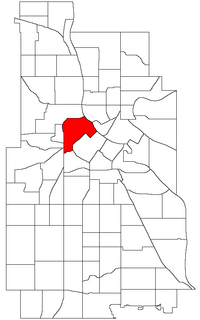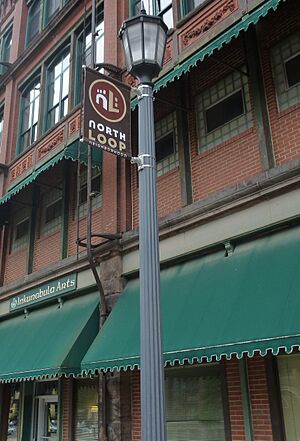North Loop, Minneapolis facts for kids
Quick facts for kids
North Loop
Market Square, Market District
|
|
|---|---|
|
Neighborhood
|
|
| Nickname(s):
The Warehouse District
|
|

Location of North Loop within the U.S. city of Minneapolis
|
|
| Country | United States |
| State | Minnesota |
| County | Hennepin |
| City | Minneapolis |
| Community | Central |
| City Council Wards | 3, 5 |
| Area | |
| • Total | 0.837 sq mi (2.17 km2) |
| Population
(2020)
|
|
| • Total | 7,540 |
| • Density | 9,008/sq mi (3,478/km2) |
| Time zone | UTC-6 (CST) |
| • Summer (DST) | UTC-5 (CDT) |
| ZIP code |
55401, 55403, 55405, 55411
|
| Area code(s) | 612 |
| Historical population | |||
|---|---|---|---|
| Census | Pop. | %± | |
| 1980 | 338 | — | |
| 1990 | 647 | 91.4% | |
| 2000 | 1,515 | 134.2% | |
| 2010 | 4,291 | 183.2% | |
| 2020 | 7,540 | 75.7% | |
The North Loop is a neighborhood in the Central area of Minneapolis. It is often called The Warehouse District. This is because it used to be Minneapolis's main business area. Back then, it was a busy shipping hub in the Midwest.
Even though less shipping happens now, the old warehouses are still a big part of the neighborhood. Many of these old buildings have been changed. They are now cool restaurants, shops, and apartments. The North Loop is also home to the Minneapolis Warehouse Historic District. This area is listed on the National Register of Historic Places. This means it's a special place with important history.
Contents
Where is the North Loop?
The North Loop is located northwest of downtown Minneapolis. It sits right next to the Mississippi River. The streets here are unique. They run at an angle to the rest of the city's streets. This is because they follow the river.
The neighborhood is divided into two parts. These parts are called Wards 3 and 5. Your local representatives, Michael Rainville and Jeremiah Ellison, serve these areas.
North Loop Boundaries
The main part of the North Loop where people live and shop is shaped like a rectangle. It is bordered by railroad tracks and the Cedar Lake Trail to the southeast. Plymouth Avenue is to the northwest. An elevated freeway entrance is to the southwest. The Mississippi River forms the northeast border. Washington Avenue is the main street that runs through the neighborhood.
Parks and Green Spaces
James I. Rice Park is in the northeast part of the North Loop. It's located along the river and is very popular in summer. A bike trail and the West River Parkway run through this park. They are part of the Grand Rounds Scenic Byway. In 2010, a playground was added to the park. You can find it where 4th Avenue North meets West River Parkway.
North Loop History
|
Minneapolis Warehouse Historic District
|
|

A look down First Avenue in the Warehouse District.
|
|
| Location | Minneapolis, Minnesota |
|---|---|
| Architect | Multiple |
| Architectural style | Classical Revival, Other, Romanesque |
| NRHP reference No. | 89001937 |
| Added to NRHP | November 3, 1989 |
For most of its past, the North Loop was an industrial area. This means it was full of factories and warehouses. It also had a large railroad yard. Many of the warehouses are now part of a historic district. This district is listed on the National Register of Historic Places.
The warehouses are usually six to eight stories tall. About 62 buildings in seven city blocks are part of this historic area. Most of them were built in the Chicago Commercial style. But you can also see other styles like Italianate and Romanesque. These warehouses were important for storing and selling goods. They were connected to the railroad network. This network linked Minneapolis to the rest of the country.
In the 1980s, the North Loop was a center for art. Many art galleries were located here. For example, the Wyman Building had over twenty art galleries. But in the 1990s, the buildings became more popular for businesses. So, many art places moved out.
The North Loop Today
Today, some factories still operate in the North Loop. But many old warehouses and factories have been changed. They are now offices, apartments, or condos. The area still feels like it has an industrial past. Many new buildings are designed to look like the old warehouses. The Hennepin Energy Recovery Center opened in 1989. It is a plant that turns waste into energy. Metro Transit also has bus garages nearby. The North Loop Bus Garage opened in 2023.
Since the mid-1990s, many people have moved to the North Loop. It's a popular place for people who work downtown. They can easily walk, bike, or take a short bus or train ride to work. Many coffee shops, restaurants, bars, and art galleries have opened here. Small retail stores have also moved into the neighborhood.
The Traffic Zone Center for Visual Art is located in the eastern part of the neighborhood. It's a well-known place for artists. The Federal Reserve Bank of Minneapolis is the largest employer here. It is located at the southwest end of the Hennepin Avenue Bridge.
In 2005, the North Loop Neighborhood Association started a project to update the neighborhood's image. They created a new logo and style guide. This helped support the area's transformation. In 2006, the association received money to build a dog park. A temporary dog park was built on N 3rd Street and N 7th Avenue.
Target Field, the home of the Minnesota Twins baseball team, opened in 2010. It is on the southwest edge of the neighborhood. There are plans to build more apartments and condos near the stadium. The area is also served by Target Field Station. This station is a hub for different train lines. These include the Northstar Commuter Rail and the Metro Transit Blue and Green Lines.
Notable Residents
- Dane Rauschenberg, author and long-distance runner




